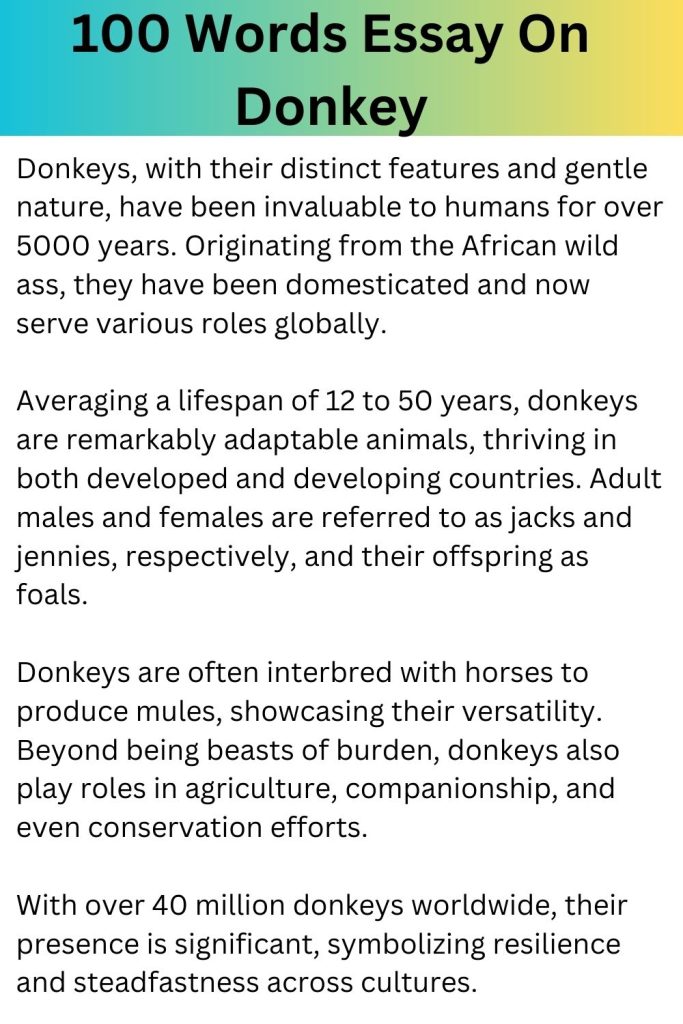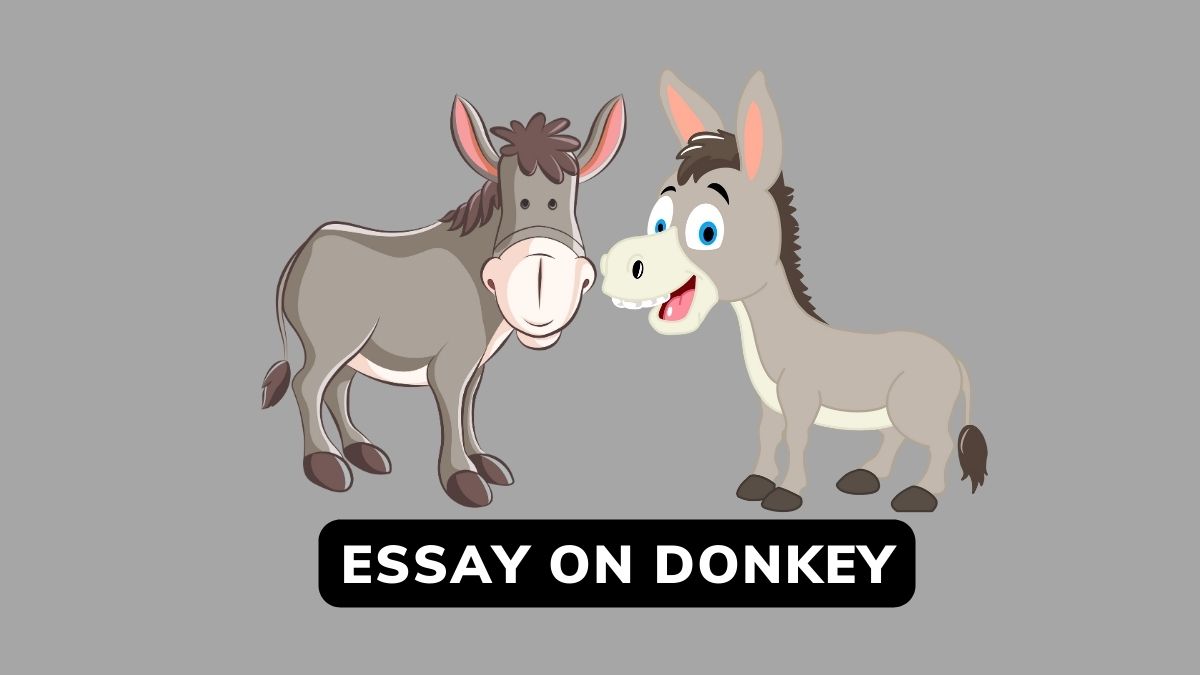Essay On Donkey in English 100 Words, Short Essay
100 Words Essay On Donkey
Donkeys, with their distinct features and gentle nature, have been invaluable to humans for over 5000 years. Originating from the African wild ass, they have been domesticated and now serve various roles globally. Averaging a lifespan of 12 to 50 years, donkeys are remarkably adaptable animals, thriving in both developed and developing countries. Adult males and females are referred to as jacks and jennies, respectively, and their offspring as foals. Donkeys are often interbred with horses to produce mules, showcasing their versatility. Beyond being beasts of burden, donkeys also play roles in agriculture, companionship, and even conservation efforts. With over 40 million donkeys worldwide, their presence is significant, symbolizing resilience and steadfastness across cultures.

Essay On Donkey in English
Donkeys, humble yet fascinating creatures, have been an integral part of human civilization for thousands of years. Their roles have evolved from ancient workhorses to present-day companions, showing versatility that few domestic animals can match. This essay delves into the world of donkeys, shedding light on their history, characteristics, and the unique bond they share with humans.
Historical Journey of Donkeys
The domestication of donkeys dates back to approximately 5000 to 7000 years ago in Africa, primarily for their utility in agriculture and transportation. Originating from the African wild ass, donkeys were among the first animals to be domesticated by humans, following closely after livestock like cattle, sheep, and goats. Their endurance, strength, and ability to carry heavy loads over long distances made them invaluable in the development of early trade routes, significantly contributing to the exchange of goods and culture between remote communities.
Understanding Donkey Behavior and Social Structure
Donkeys are known for their social nature and intelligence. They typically live in groups ranging from a few to several members, demonstrating complex social behaviors that are vital for their survival. Contrary to popular belief, donkeys are not stubborn; this misconception arises from their strong sense of self-preservation. They are cautious animals, often hesitating before engaging in unfamiliar or potentially dangerous situations. This characteristic, mistaken for stubbornness, is actually a testament to their intelligence and discerning nature.
Physical Attributes and Lifespan
Donkeys come in a variety of sizes and colors, with the most common being white, black, grey, brown, and light brown. They are characterized by their distinctive long ears, which not only contribute to their acute hearing but also help regulate their body temperature in hot climates. Donkeys have a lifespan significantly longer than many other domestic animals, with an average age ranging between 25 to 30 years, though some have been known to live beyond 40 years under good care.
Reproduction and Growth
The reproductive process of donkeys is fascinating. A female donkey, known as a jenny, carries her young for 11 to 13 months before giving birth, typically to a single foal. The mare’s fertility peaks immediately after giving birth, a period during which she temporarily leaves her group to protect the newborn from male donkeys. This natural instinct ensures the safety and well-being of the foal during its most vulnerable early days.
Roles and Responsibilities
Originally bred for labor, donkeys have been employed in various capacities: from tilling fields and transporting goods to milling and water drawing. In modern times, while their role in developed countries has shifted more towards companionship and therapy, in many parts of the world, donkeys still play a crucial role in agriculture and transport, especially in less developed regions. Their hardy nature and ability to thrive on minimal resources make them particularly suited to harsh environments where other domestic animals might not survive.
The Mammoth Donkey: A Breed Apart
A special mention is warranted for the Mammoth Donkey, also known as the American Ass, which stands out due to its impressive size and strength. Originating from a mix of European donkey breeds, this breed showcases the incredible diversity within the species. Despite their formidable appearance, Mammoth Donkeys are gentle giants, known for their friendly disposition and strong affinity towards humans.
Conclusion
Donkeys are much more than the caricatures often portrayed in popular media. They are intelligent, adaptable, and resilient animals with a rich history of aiding humanity. Understanding donkeys’ nuanced behaviors and social structures enriches our appreciation for these extraordinary creatures. As we continue to explore the depth of our relationship with donkeys, it becomes evident that they are not merely beasts of burden but rather, cherished companions that have walked alongside humans through the ages, shaping our history and enriching our lives.
Short Essay On Donkey
The world of domesticated animals is vast and varied, hosting creatures ranging from the smallest of household pets to the giants that labor in our fields. Among these, the Mammoth Donkey, or the Mammoth Jack as it is also known, holds a place of distinction. Unlike the common donkey familiar to many, the Mammoth Donkey is a breed apart, showcasing unique attributes that underscore its significance in both history and modern times.
Origins and Breeding
The genesis of the Mammoth Donkey is a tale of careful selection and breeding. Originating in the United States, this breed came into being through the crossbreeding of several European donkey breeds, including the Maltese, Poitou, Andalusian, and Catalonian. This amalgamation gave rise to what is known today as the American Jackstock, a term that denotes the male of the species, with females referred to as Jennets. This nomenclature is part of the breed’s rich heritage, underscoring its distinct lineage and characteristics.
Physical Stature
Standing as the largest donkey breed in the world, the Mammoth Donkey commands attention. Its size is not just for show; it reflects the breed’s strength and capability. These donkeys can weigh up to 950 pounds, combining robustness with a surprisingly gentle demeanor. Despite their imposing size, Mammoth Donkeys are known for their affinity towards humans, a trait that makes them both admirable and highly sought after for companionship and work.
Behavior and Temperament
The behavior of the Mammoth Donkey belies its size. Known for their gentle nature, these animals form strong bonds with humans, offering friendship and loyalty. However, their demeanor is also a testament to their intelligence and self-awareness. They respond best to kind treatment and can become steadfast companions when raised with care from a young age. Conversely, neglect or mistreatment can lead to a distrustful and potentially dangerous animal, a testament to their strong sense of self-preservation and memory.
Utility and Conservation
The utility of Mammoth Donkeys extends beyond their physical strength. Historically, they have been indispensable as working animals, contributing to agriculture and transportation. Their endurance and ability to carry heavy loads have made them valuable assets in many settings. In modern times, while their role as beasts of burden has diminished in developed countries, they continue to be treasured as pets, for breeding, and in conservation efforts to maintain the breed’s lineage and characteristics.
A Living Legacy
The Mammoth Donkey represents a living legacy of animal husbandry and the enduring bond between humans and domesticated animals. Through careful breeding and nurturing, this breed has carved out a niche that underscores the diversity within the world of domesticated animals. As we move forward, the Mammoth Donkey stands as a reminder of our shared history with these gentle giants and the importance of preserving the genetic diversity and unique characteristics of all domestic breeds.
In conclusion, the Mammoth Donkey is more than just a larger counterpart to its common relatives. It is a symbol of the rich tapestry of domesticated animal breeds, showcasing the remarkable results of selective breeding and the enduring bond between humans and animals. As we continue to learn from and with these majestic creatures, they remind us of the importance of kindness, care, and respect in all our interactions with the natural world.







